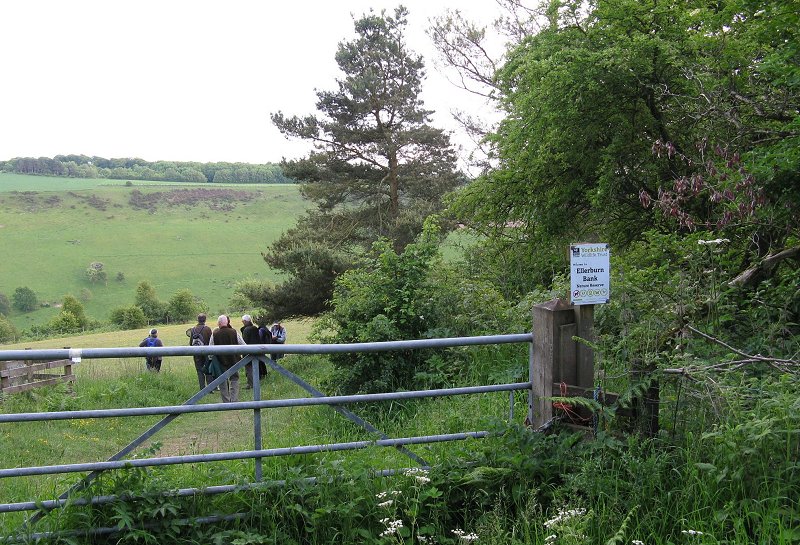
RNHS members on the reserve
Back to the Home page
Species lists below

RNHS members on the reserve
On what proved to be a delightful summer’s evening, 17 members turned out to take a look at this gem of a nature reserve situated on the eastern boundary of the Society’s recording area. At just under three hectares this remnant of limestone grassland has a rich diversity of plant life that is at its best in the months of June and July.
Ellerburn Bank was awarded SSSI status in 1983 for its species-rich calcareous grassland flora and is managed as a nature reserve by the Yorkshire Wildlife Trust. Management is generally limited to a late Autumn graze with Hebridean sheep in order to keep an open sward and prevent the spread of tor grass and scrub; though work tasks are occasionally organised to remove the patches of scrub that do not get grazed sufficiently by the sheep.
Other features of the site include an ancient earthwork running along the western boundary that is thought to be late Bronze Age and forms the bank and ditch structure that is a prominent feature on this side of the reserve. On the north side the remains of a rabbit warren pit trap can be seen, with the hole through the dry-stone wall still in place, but the stone lined pit, that originally would have had a wooden trap door, is now filled in with rubble – another victim of health and safety, no doubt. The rabbit warren industry was big business in the 19th and early 20th century with the pelts being sought after for top hats; the traps ensuring the fur was not damaged as would be the case if the rabbits had been shot.
A list of plants and birds that were recorded on the event are included below, but of note during a delightful amble around the reserve were Common Spotted, Northern Marsh, Fly and Greater Butterfly orchids; the later being confined to just a single specimen in the north-east corner that had been surrounded with a wire cage to keep out the numerous rabbits that graze on the reserve. Also a solitary and rather poor specimen of Common Twayblade was seen at the southern end of the reserve. Many other limestone specialists were seen such as Rockrose, Carline Thistle, Hoary Plantain and Dropwort. We also saw a fine spcimen of Burnet Rose (the aptly named Rosa spinosissima growing on the earthwork, as well as a fine fly orchid.
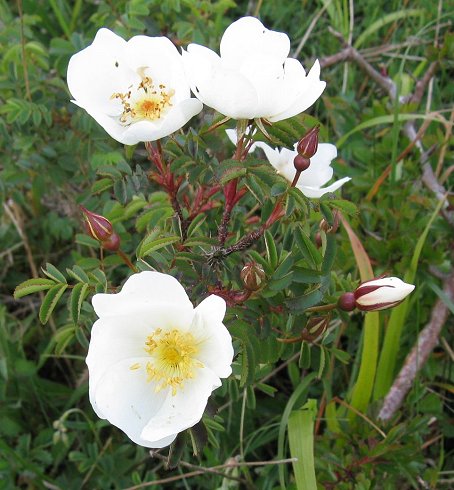 Burnet Rose |
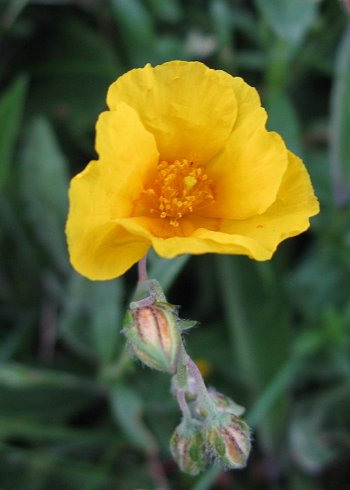
Rockrose |
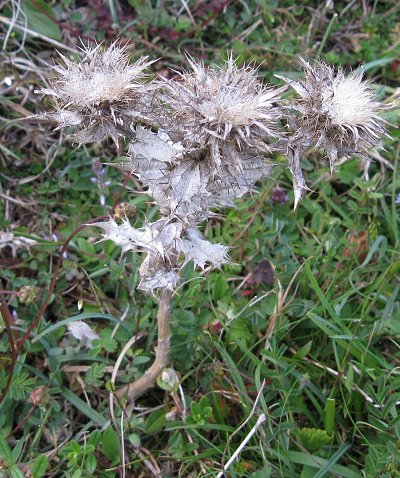 Carline thistle (seedheads from last year) |
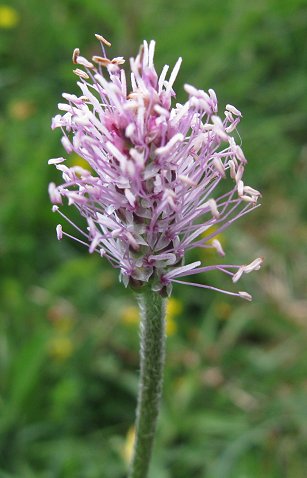
Hoary plantain |
The Common Spotted and Northern Marsh orchids belong to the genus Dactylorhiza in which there is a good deal of variation within species, and also considerable hybridisation between species. We saw a few specimens that were very dark for Common Spotted and which may well be a hybrid with a marsh orchid.
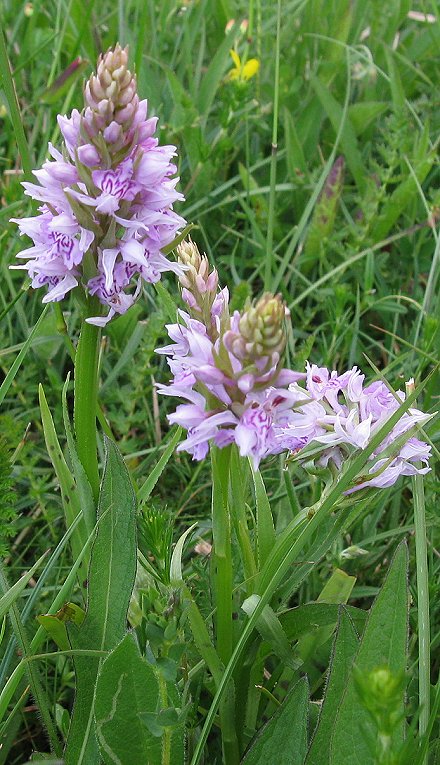 Common spotted orchid (typical pale pink/mauve form) |
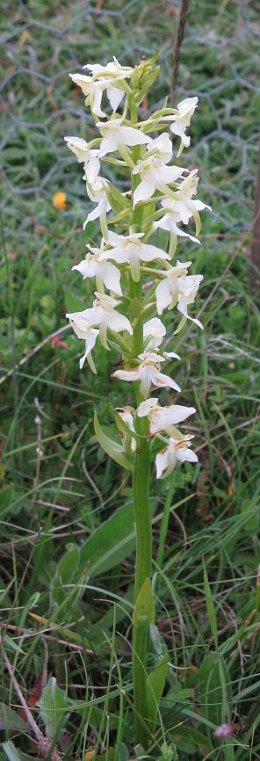
Greater butterfly orchid |
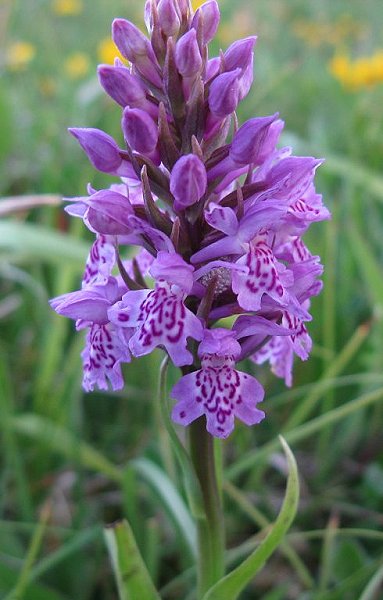 Spotted orchid (probable hybrid between a spotted and an marsh orchid) |
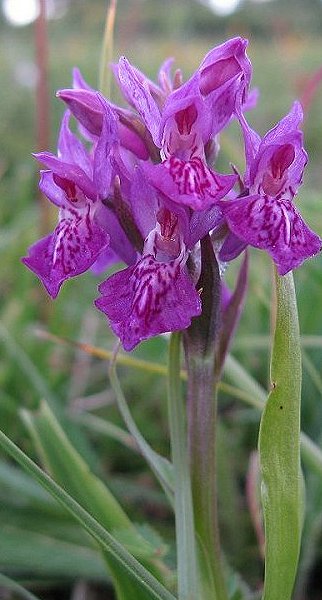
Northern marsh orchid, showing the darker colour and undivided lip |
To the relief of some, no adders were seen on this occasion though the eastern slope of the reserve is noted for them where they can often be seen during the summer months basking in the warmth of the sun. A good view of a slow-worm was observed by a few members when a large stone by the northern boundary wall was lifted revealing an unusually docile specimen. Often mistaken for a snake, the slow-worm is, in fact, a legless lizard.
Outside the reserve, along Pexton Bank, Columbine (wild Aquilegia) was noted while on the return a good display of Welsh Poppies were seen behind the toll booth. No butterflies were recorded, which was to be expected at this time of day, but interesting specimens of Common Swift and Green Carpet moth were recorded; these being netted enabling members to study them at close quarters. And for a lucky few, a fleeting glimpse of a Goshawk at the start of the walk.
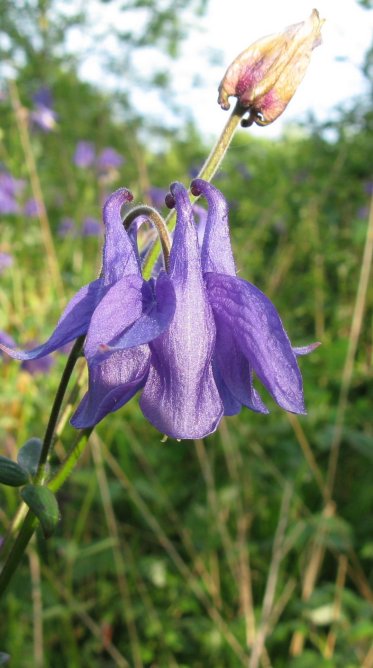 Columbine (the wild plant has blue flowers) |
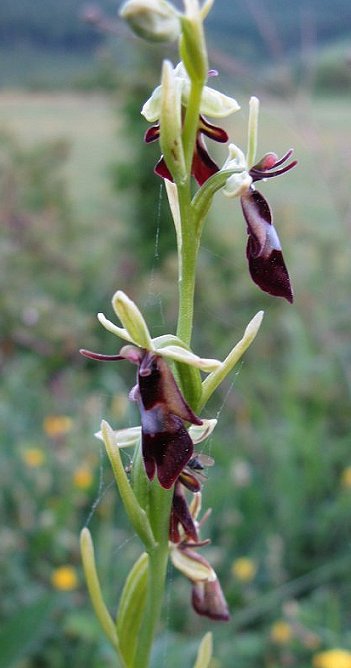
Fly orchid |
The event ended just before 10pm back at Haygate car park as the sun was setting. A couple of members thought they heard a woodcock roding but the bird was not seen. All agreed it had been a thoroughly enjoyable evening and Ken was thanked for leading it.
[Ed. GS] I did not record all plant species, for instance many grasses and ferns; my thanks to Margaret Reynolds for her list to add to mine.
| Latin name | English name |
|---|---|
| Agrimonia eupatoria | Common agrimony |
| Ajuga reptans | Bugle |
| Anthriscus sylvestris | Cow parsley |
| Anthyllis vulneraria | Kidney vetch |
| Aquilegia vulgaris | Columbine |
| Bellis perennis | Daisy |
| Briza media | Quaking grass |
| Carex flacca | Glaucous sedge |
| Carex sylvatica | Wood sedge |
| Carlina vulgaris | Carline thistle |
| Centaurea nigra | Common knapweed |
| Centaurea scabiosa | Greater knapweed (leaves only, id uncertain) |
| Cerastium fontanum | Common mouse-ear |
| Cirsium eriophorum | Woolly thistle |
| Cirsium palustre | Marsh thistle |
| Crataegus monogyna | Hawthorn |
| Cruciata laevipes | Crosswort |
| Dactylorhiza fuchsii | Common spotted orchid |
| Dactylorhiza purpurella | Northern marsh orchid |
| Dactylorhiza sp. | Spotted orchid hybrid |
| Deschampsia flexuosa | Wavy hair grass |
| Dryopteris dilatata | Common buckler fern |
| Dryopteris filix-mas | Male fern |
| Filipendula vulgaris | Dropwort |
| Fragaria vesca | Wild strawberry |
| Fumaria officinalis | Common fumitory |
| Galium aparine | Cleavers |
| Galium saxatile | Heath bedstraw |
| Galium verum | Lady’s bedstraw |
| Geranium robertianum | Herb Robert |
| Geum urbanum | Wood avens |
| Helianthemum nummularium | Rockrose |
| Helictotrichon pratense (Avenula pratensis) | Meadow oat (id uncertain) |
| Heracleum sphondylium | Hogweed |
| Holcus mollis | Creeping soft grass |
| Hyacinthoides non-scripta | Bluebell |
| Linum catharticum | Fairy flax |
| Listera ovata = Neottia ovata | Twayblade |
| Lotus corniculatus | Common birdsfoot trefoil |
| Lotus pedunculatus | Greater birdsfoot trefoil |
| Lysimachia nemorum | Yellow pimpernel |
| Meconopsis cambrica | Welsh poppy |
| Medicago lupulina | Black medick |
| Myosotis sp. | Forgetmenot (probably field forgetmenot) |
| Neottia nidus-avis | Orchid |
| Oenanthe crocata | Hemlock water dropwort |
| Ophrys insectifera | Fly orchid |
| Origanum vulgare | Marjoram |
| Plantago lanceolata | Ribwort plantain |
| Plantago media | Hoary plantain |
| Platanthera chlorantha | Greater butterfly orchid |
| Polygala vulgaris | Common milkwort |
| Potentilla anserina | Silverweed |
| Potentilla erecta | Tormentil |
| Ranunculus acris | Meadow buttercup |
| Ranunculus repens | Creeping buttercup |
| Reseda lutea | Mignonette |
| Rhinanthus minor | Yellow rattle |
| Rosa canina | Dog rose |
| Rosa mollis | Downy rose |
| Rosa pimpinellifolia = R. spinosissima | Burnet rose |
| Sambucus nigra | Elder |
| Sanguisorba minor = Poterium sanguisorba | Salad burnet |
| Sanicula europaea | Sanicle |
| Scabiosa columbaria | Small scabious |
| Silene dioica | Red campion |
| Silene vulgaris | Bladder campion |
| Sinapis arvensis | Charlock |
| Thymus polytrichus | Thyme |
| Trifolium pratense | Red clover |
| Trifolium repens | White clover |
| Trisetum flavescens | Yellow oat |
| Ulex europaeus | Gorse |
| Veronica chamaedrys | Germander speedwell |
| Veronica officinalis | Heath speedwell |
| Viburnum opulus | Guelder rose |
| Vicia sepium | Bush vetch |
Common Swift Moth
Green Carpet Moth
Slow-worm
| © Ryedale Natural History Society 2015, Photos © Gill Smith 2015 |